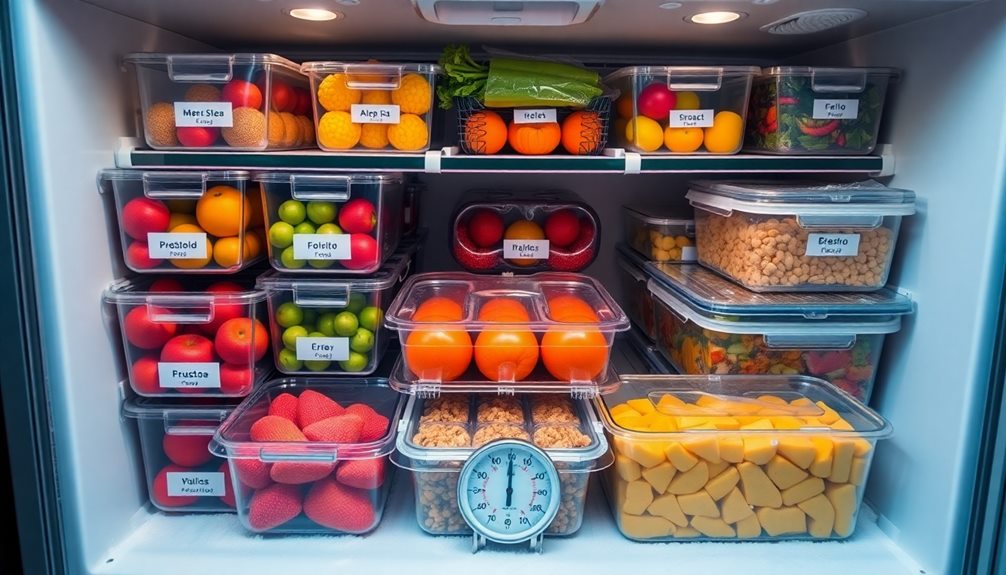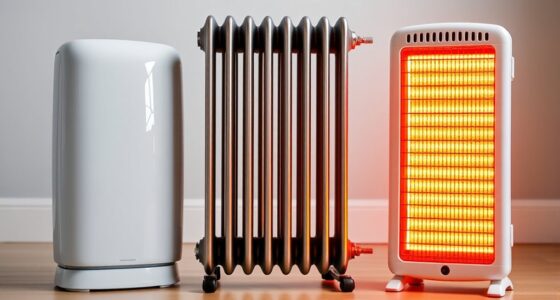To organize your freezer like a pro, start by taking an inventory of what you have. Use clear bins to categorize items, labeling each for easy access. Group similar foods together—meats, vegetables, and prepared meals—and organize by expiration dates to use older items first. Keep items flat in bags to save space and guarantee proper airflow. Regularly check for expired foods and remove them to maintain cleanliness. By following these steps, you'll streamline your meal prep and reduce waste effortlessly. There's plenty more to discover about maximizing your freezer's efficiency, so keep exploring the best practices!
Key Takeaways
- Conduct a thorough inventory of your freezer contents to track items and prioritize usage effectively.
- Utilize clear, labeled bins and containers to categorize and identify frozen items easily.
- Organize similar items together and arrange by expiration dates to promote first-in, first-out usage.
- Maintain proper airflow by avoiding overpacking and stacking items flat in bags or containers.
- Schedule regular maintenance, including defrosting and cleaning, to prevent ice buildup and ensure food safety.
Best Practices for Freezer Organization
When you take the time to organize your freezer, you not only save space but also reduce food waste. Start by conducting an inventory of your freezer contents; this helps you track what you have and guarantees you use older items first.
Utilize storage bins and magazine holders to categorize your frozen items efficiently. By grouping similar items together—like meats, vegetables, and leftovers—you create a designated space for everything, simplifying your inventory management and meal planning.
Don't forget to incorporate clear labeling! Label all bins and containers with their contents and storage dates for easy identification. This practice reduces the chances of forgetting items tucked away in the back, which can lead to wasted food.
Regularly check your freezer for expired items, and promptly remove any unwanted food to maintain organization and guarantee quality.
Understanding Different Freezer Types
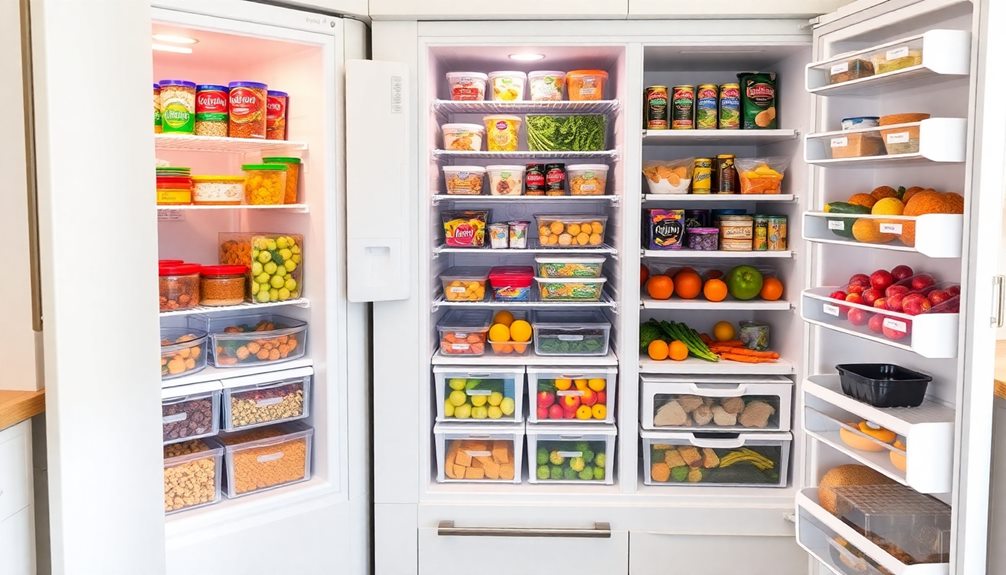
Understanding the various types of freezers can greatly enhance your food storage efficiency. Each of the main freezer types—upright, chest, side-by-side, bottom, and top freezers—has unique characteristics that require tailored organization methods to maximize space and accessibility.
For upright freezers, create specific zones for each shelf to keep similar items together, which makes everything easier to find.
Chest freezers, on the other hand, benefit from using various sized bins to layer your food effectively. This helps you utilize the depth of the freezer while maintaining visibility.
Side-by-side freezers are great for easy access; place skinny bins in the doors to store smaller items, so they're right at your fingertips.
If you have a bottom freezer, stack like items to avoid losing track of your food, positioning frequently used items at the top for quick access.
Essential Supplies for Organization
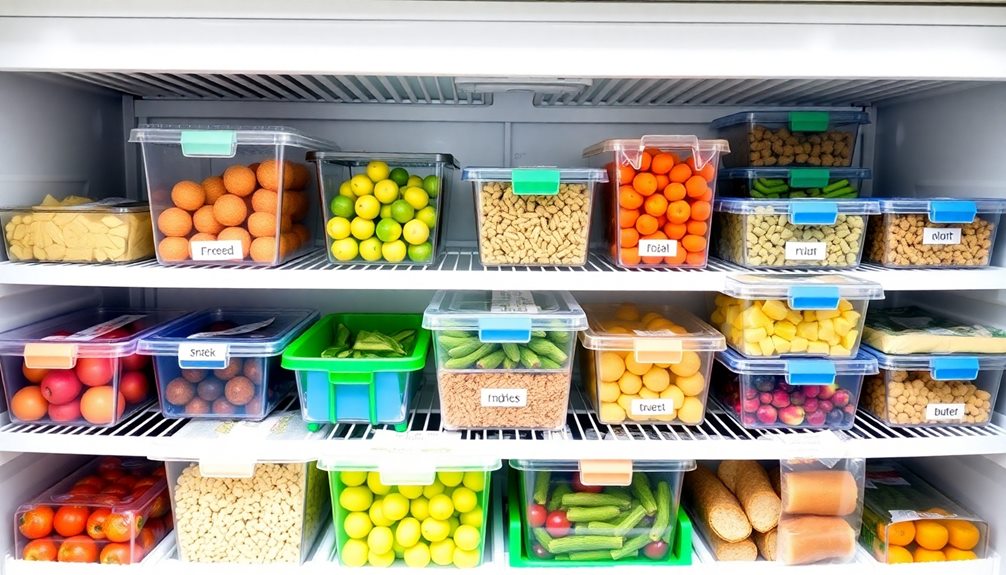
To effectively organize your freezer, you'll need a selection of essential supplies that enhance accessibility and efficiency. Start by investing in various sizes of freezer bins and organization containers, ideally clear bins, to categorize and easily access your frozen items while maximizing space.
Labels are vital—apply them to all containers to clearly identify contents and storage dates. This practice simplifies inventory management and greatly reduces food waste.
Airtight containers and freezer-safe bags are must-haves, as they prevent freezer burn, ensuring your food maintains quality and flavor during storage.
Consider stackable options for your containers; this will optimize vertical space in your freezer, further improving organization and accessibility of items.
Inventory Management Techniques
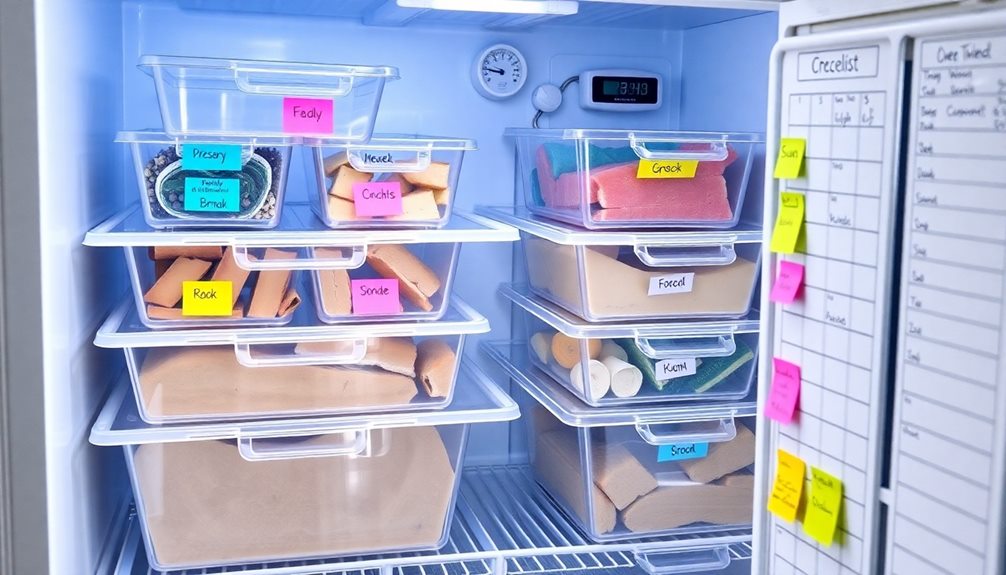
To keep your freezer organized, regular inventory updates are key.
Make it a habit to document expiration dates so you can prioritize using older items and reduce waste.
This simple practice not only enhances food safety but also streamlines your meal planning process.
Regular Inventory Updates
Keeping your freezer organized can greatly enhance your meal planning and reduce food waste. One effective way to achieve this is by regularly creating and updating a freezer inventory list. This allows you to track contents and guarantee that older items are used first, minimizing waste and maximizing freshness.
Using a whiteboard or a dedicated app can simplify this process, enabling quick updates while you're grocery shopping. It's also essential to document purchase or expiration dates on your inventory list to maintain food safety and avoid consuming spoiled items.
After you use something, remove it from the inventory list promptly to keep the record accurate and up-to-date.
Don't forget to schedule a yearly reset of your inventory. This gives you a chance to assess and reorganize your freezer, ensuring all items remain accessible and expired products get discarded.
Document Expiration Dates
Documenting expiration dates is essential for effective inventory management in your freezer. By keeping track of contents and noting expiration dates, you can minimize waste and guarantee food safety. Regularly update your freezer inventory list, and utilize a simple system like a whiteboard or an app to document purchase dates during grocery shopping.
Here's a quick reference table to help you manage expiration dates:
| Item Type | Maximum Freezer Life | Notes |
|---|---|---|
| Fresh Poultry | Up to 9 months | Label items with date |
| Cooked Meat | 2 to 6 months | Use first-in first-out |
| Vegetables | Up to 12 months | Remove expired foods |
| Bread | 3 to 6 months | Track usable portions |
| Soups & Stews | 2 to 3 months | Document purchase dates |
Make sure to clearly label items with their storage dates. This helps you identify what needs to be used first, promoting a first-in, first-out approach. Always remove expired items promptly to maximize freezer space and guarantee only safe food is stored.
Efficient Item Organization Strategies
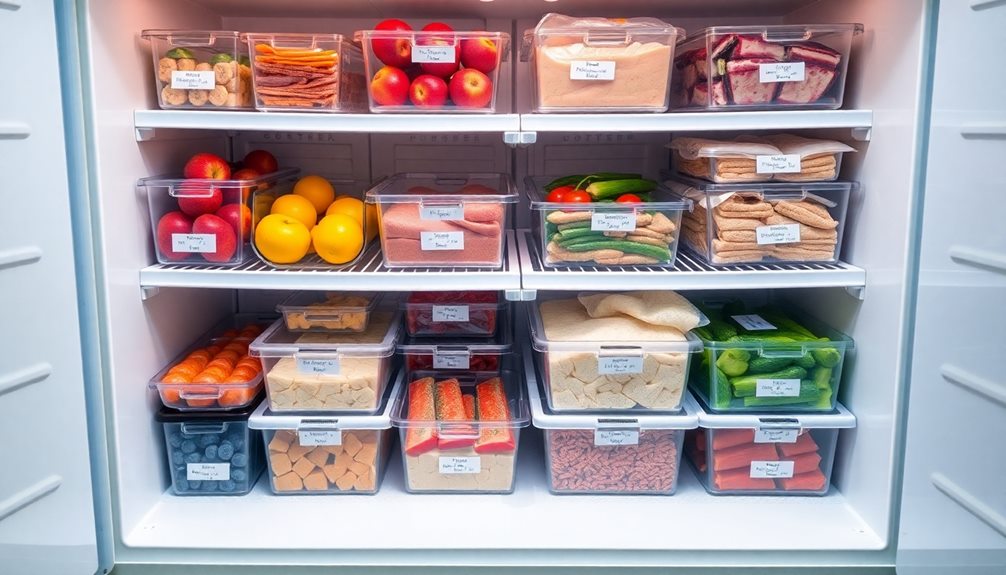
Organizing your freezer efficiently can save you time and reduce food waste. Start by grouping similar items together, such as meats, vegetables, and prepared meals. This freezer organization strategy enhances visibility and streamlines the retrieval process.
Organize your items by expiration dates, placing older items towards the front to encourage their use before newer stock. To facilitate quick identification and efficient inventory management, clearly label all bins and containers with their contents and storage dates. This practice helps you know what you have on hand without digging through everything.
When organizing, be mindful to avoid overpacking your freezer. Proper airflow is essential for maintaining consistent temperatures and preventing freezer burn. Additionally, store items flat in bags or containers to maximize space. This technique allows for easier stacking and simplifies the process of accessing and identifying your frozen goods.
Maintenance and Cleaning Practices
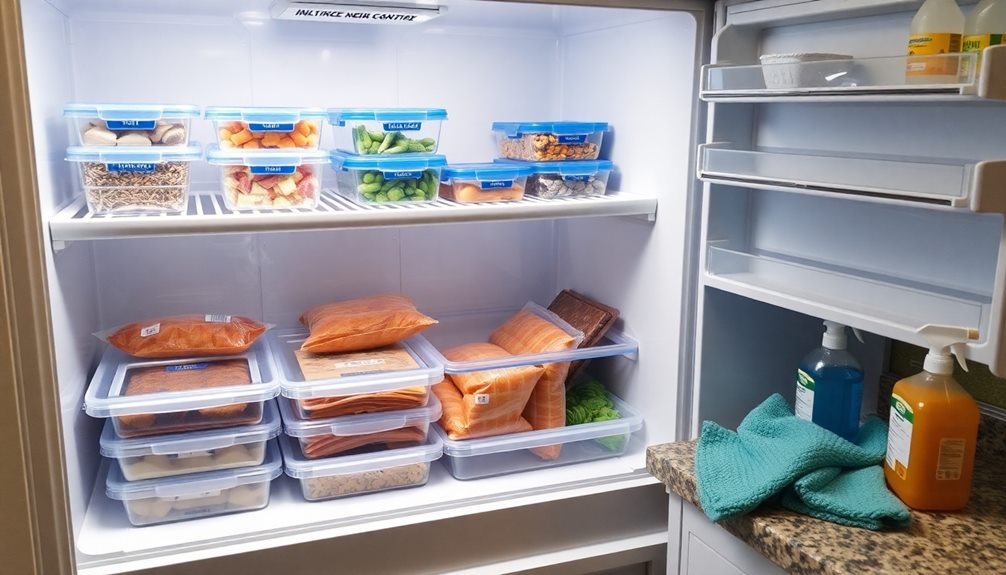
Maintaining a clean and efficient freezer is crucial for peak performance. Schedule regular defrosting every 6 to 12 months to prevent ice buildup, which can reduce your storage capacity.
When defrosting, take the opportunity to conduct a thorough cleaning. Remove all items, and wipe down surfaces using a mixture of vinegar and water to eliminate odors and maintain hygiene.
Check seals on your freezer doors at least quarterly. Confirming they close properly can prevent frost buildup and energy loss.
It's also important to dispose of expired or unwanted items every month to keep your freezer organized and functional, minimizing food waste.
After cleaning, inspect for any signs of freezer burn or spoilage to guarantee your food remains safe and tasty.
This maintenance routine won't only extend the life of your freezer but also enhance its efficiency. By integrating these cleaning practices into your schedule, you'll create a more organized environment, making it easier to find what you need while enjoying the benefits of a well-maintained appliance.
Tips for Long-Term Food Storage
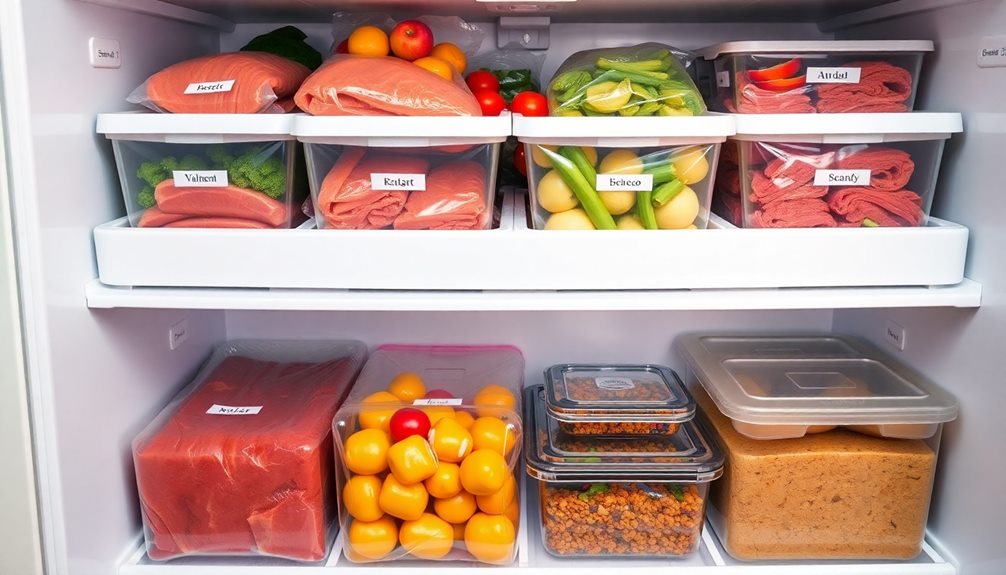
After you've established a routine for cleaning and maintaining your freezer, it's time to focus on how to store food for the long haul.
To guarantee effective long-term food storage, utilize airtight containers and vacuum-sealed bags. These methods help prevent freezer burn, which can result from moisture loss and air exposure.
For peak quality, fresh poultry can be stored for up to nine months, while steaks, chops, and roasts last between four to twelve months depending on the cut. Lean fish varieties, like cod and flounder, are best consumed within six to eight months.
Cooked meats and poultry should ideally be eaten within two to six months to avoid quality degradation.
It's vital to regularly check your freezer and rotate items based on their storage dates. This practice not only minimizes waste but also maintains food safety.
By keeping track of what you have, you can enjoy your meals at their best quality.
Signs of Freezer Burn and Prevention
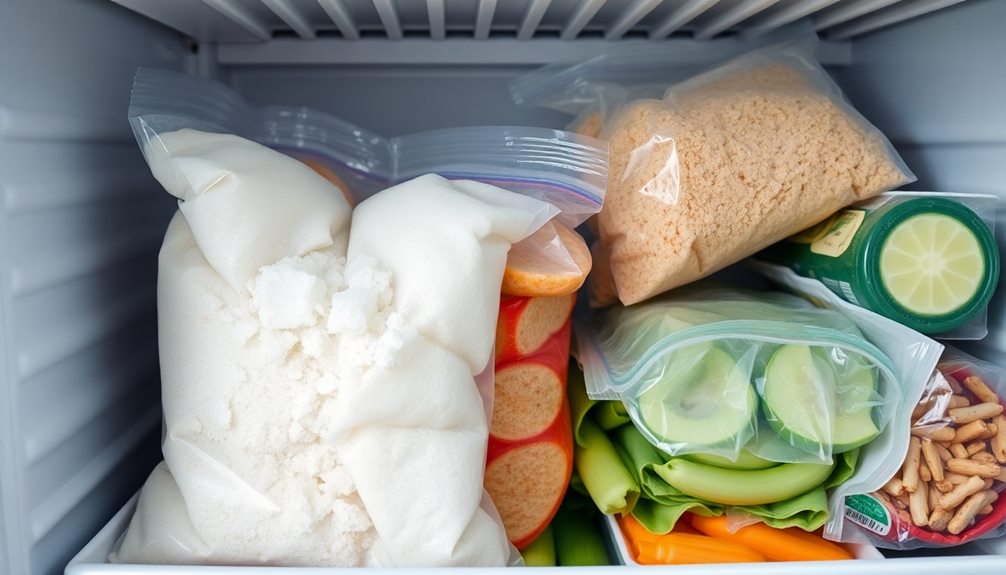
Freezer burn can be a frustrating issue that affects the quality of your frozen food. It occurs when moisture evaporates, leading to dehydration, off-flavors, and noticeable signs like discoloration, ice crystals, and shriveled textures, especially in fruits and vegetables.
To prevent freezer burn, use airtight containers or vacuum-sealed bags. These options minimize moisture exposure and help preserve your food's integrity.
Make it a habit to regularly check seals on freezer bags and containers. Compromised seals can increase air exposure, putting your food at risk. Additionally, adhere to ideal freezing times—fresh poultry should be consumed within nine months, while cooked meat is best within two to six months.
Maintaining a consistent temperature of 0°F (-18°C) or lower is essential. This temperature slows the freezer burn process and guarantees your food remains in prime condition.
Frequently Asked Questions
What Is the Best Way to Organize Your Freezer?
To organize your freezer effectively, group similar items, use labeled bins for visibility, implement a first-in, first-out system, maintain an inventory list, and adopt proper freezing techniques to optimize space and reduce waste.
How Do I Get the Most Space in My Freezer?
Imagine your freezer bursting with neatly stacked, labeled bags. To maximize space, freeze items flat, use clear bins for grouping, and vacuum seal to eliminate air. Regularly check and rotate to keep everything accessible and fresh.
Where to Put Things in the Freezer?
To maximize your freezer's efficiency, place everyday items at eye level in the middle, raw meats on the bottom, and use the door for less sensitive items. Store fruits and veggies on the top shelf.
What to Keep in a Freezer Door?
You should keep items in the freezer door that tolerate temperature changes, like nuts and butter. Use the top shelf for bread and breakfast items, and store sauces and prepared meals on the next shelf down.
Conclusion
By following these tips, you'll transform your freezer into a well-organized haven that not only saves time but also reduces waste. Imagine opening that door and seeing everything neatly arranged, ready for your culinary creations! With the right supplies and strategies, you can guarantee your food stays fresh and accessible. So, why let chaos reign in your freezer when a little organization can bring order and efficiency to your kitchen? Start today and savor the benefits!
